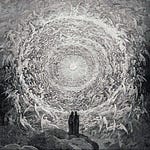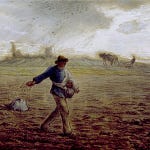Last weekend we launched the first Three Things Bible Course for members. You can listen to the audio from the first session for free. If you want to join us for the rest of the course, you can sign up here.
Genesis is the seedbed out of which the major symbols and images in the whole Bible grow.
It sometimes seems like if you shake the first three chapters of the Bible, the rest of the Bible will come tumbling out of them.
The beginning of Genesis is not just about how things came to be, as if, once we have used it to establish the macro-evolution is false, we can just move on to more important parts of the Bible. Rather, the beginning of Genesis is like a star around which the rest of the Bible orbits and to which it is oriented.
If you survey many of the Bible’s major themes: good and evil, light and darkness, obedience and rebellion, the image of God, the temple, priesthood, the sabbath, exile, sacrifice, redemption, the Holy Spirit, heaven and earth, holiness, and so on—all of them start with Genesis.
It follows that if you want to know what the Bible is saying, you need to begin to understand what Genesis is saying. In the next few posts, we are going to trace the symbol of water through the book of Genesis (and beyond), starting with the primeval sea in the first two verses of the Bible.
The Primeval Sea | Genesis 1:1-2
“1 In the beginning, God created the heavens and the earth. 2 The earth was waste and wild, and darkness was over the face of the deep. And the Spirit of God was hovering over the face of the waters.”
Key Words
God (Elohim): A plural word that appears throughout the Bible to refer to both the one ruling God, Yahweh and the divine council of spiritual beings (both good and evil) whom he uses as secondary powers to rule the earth.
Heavens (Shamayim): The visible universe above the earth and the invisible abode of God. The place of the “waters above.”
Earth (erets): Land itself, the whole earth, in particular, the land of Canaan, the promised land.
Without form (Tohu): Confusion, unreality, the wasteland, a place of chaos.
Void (Bohu): Emptiness, void, waste.
Deep (Tehom): The deep sea, the primeval ocean, the “waters below”. Also, the abyss or the grave. The deep is the place of Job’s leviathan and the word for the waters of death that sweep in over Pharaoh's armies after the Hebrews have safely crossed the Red Sea (yam suph, the sea of reeds).
Spirit (Ruach): Breath, wind, and spirit.
Hovering (rachaph): To hover. This word is used only twice in the Bible, here and in Psalm 32, where God is depicted as a bird who has found Israel in the wasteland (tohu) of the wilderness and hovers (rachaph) over the people like an eagle does over its young, carrying them and protecting them in the midst of the chaos.
Darkness (choshekh): Darkness, obscurity, a secret place. This darkness is the absence of light, night, and the darkness of the covering clouds which often accompany descriptions of God, for instance, in the Psalms.
Genesis starts in a watery wasteland
Even in the first two verses, Genesis is calling the tune the images of the rest of the Bible will march to. Meanings that are established here will run straight through the symbolic imagery of the rest of the Bible. The meaning of the sea is no exception.
The Bible doesn’t begin with the Spirit of God hovering over a gently flowing stream (that is later) or a peaceful, calm sea (again, later). Also, surprisingly, in Genesis, the creation doesn’t begin with nothing either (though it does elsewhere). Rather, the uncreated state is an odd, dual image.
The Spirit of God is hovering over a creation that is described as:
A wild wasteland—The words “formless and void” are better translated as “wild and waste.” Both tohu (formless) and bohu (void) carry connotations of the wasteland, the wild desert places where life can’t flourish. They are used elsewhere in the Bible to describe ruined cities (Isaiah 24:10 and 34:11) or the desert (Deuteronomy 32:10, Job 6:18, and Psalm 107:40).
A chaotic sea—Water appears twice in these verses: “the deep” (tehom) that the darkness covers and“the waters” (may) that the Spirit is hovering over.
Let’s look at the second of those two images.
The “primeval sea” is the uncreated state, the chaos that preceded God’s ordering of creation. These are the waters of uncreation where no life can flourish, no meanings can take root, no order can take shape. It is the opposite of the good place God is about to bring about as the first chapter of Genesis unfolds.
What does the “Primeval Sea” Mean?
The sea was an image of chaos and death for the Hebrew people. They shaped the scriptures to reflect that symbolic meaning and were in turn shaped by them, deepening the association.
Remember, they didn’t have the heavy, iron-sided ocean-going vessels we have today. Their ships were small and vulnerable. They didn’t have satellite imagery and meteorology to tell them when storms were coming across the waters. They didn’t have the knowledge we have of all the many creatures of the sea. (Can you imagine what it might have been like to see a whale appear next to your tiny fishing dinghy back then? No wonder they believed in sea monsters.) On a practical level, the sea was not a place for humans; it was dangerous and often deadly.
However, the association between the sea and chaos, evil, and death was not only a practical reality; it was also a mythological one.
At this point, we need to take a not-so quick digression into the creation stories of Israel’s ancient neighbors.
Genesis Is In Dialogue With Pagan Creation Stories
The creation stories of Israel’s enemies (Babylon, Assyria, Egypt, and the Canaanites) form part of the cultural context of the ancient Hebrew imagination.
For a modern analogy, you might think of the way that British stories of King Arthur and Robin Hood form part of the context of the cognitive framework of the West. If someone says, “He is a real Robin Hood,” the meaning doesn’t need to be explained. The speaker is creating new meanings by taking a common cultural understanding and applying it in a new context—and we understand that someone is figuratively robbing from the rich and giving to the poor.
Culture, language, and literature worked the same way in ancient times.
Israel’s neighbors had their own ideas about how everything came to be and the Bible is in dialogue with the alternate contemporary meta-stories.
When you compare Genesis with other ancient creation stories you find surprisingly similarities and differences.
For instance, the Babylonian creation story, the Enuma Elish, begins with two gods, Apsu (fresh water) and Tiamat (chaotic salt water). That’s it. They didn’t conceive of the uncreated state as being nothing. They thought of it as being landless water.
Similarly, in one of the Egyptian creation stories, the creator god is called Atum and he arises from the ocean and transforms himself into the land. The key thing to notice for our discussion is that, again, non-existence isn’t nothingness; it is the sea.
Now let’s go back to Genesis 1:1-2.
Situating the Hebrew creation story in an oceanic wasteland both evokes this primeval mythological ocean and subverts it.
Notice the differences between the pagan myths and Genesis.
In the Egyptian story, Atum is not eternally-existent (unlike the God of the Bible), rather, he creates himself from the primordial sea, which pre-existed him. In Genesis, the uncreated state is also depicted as chaotic water, but God pre-existed it, created it, and rules over it.
Unlike the Babylonian creation story, creation doesn’t come about by two gods procreating. In Genesis, God simply speaks and new things are brought into being by his word alone. When God speaks and the tempest is stilled, the chaos is given meaning and order, and the waters divided.
Also, there is no struggle to create in Genesis. God is not a part of the sea, but hovers over it, ruling it. These waters “saw God and writhed” (Psalm 77:16). The Spirit is immanent, present, moving like a wind over the waters. The Spirit of God hovers over the chaos as a bird riding the thermals. God’s Spirit is poised like indrawn breath waiting to exhale life and the words of creation.
Where does the image of the primeval sea of chaos appear elsewhere in the Bible?
The first verses of Genesis depict the Spirit of God hovering over a chaotic, disordered sea. That dense idea becomes one of the many images that later biblical writers draw from again and again when they, inspired by the Holy Spirit, are crafting their own works.
Let’s think about it, when do the waters appear as a force of chaos, danger, and death?
The Flood. Genesis 1 is the story of God separating the waters to clear a space for his creation to grow and flourish. Just a few chapters later, however, humanity has made such a wreck of God’s creation that he is going to start over. What is his chosen agent of destruction? The sea of chaos. The flood narrative is told as a reversal of what God accomplished in creation in Genesis 1. The “the fountains of the great deep (tehom) burst forth, and the windows of the heavens were opened.” (Genesis 7:11). The “great deep” is the same deep the Spirit was hovering over in Genesis 1:2. Now it has returned to act as an instrument of God’s judgment.
The Crossing of the Red Sea. In Exodus 14, God made the sea into dry land for the Israelites by separating it (as he also separated it in Genesis 1), but the sea becomes death for the Egyptians when they try to follow and it closes around them. Exodus 15 retells the story in poetic form and the Egyptians are depicted as being “covered by the deep (tehom)” into which they “sank like a stone” (Exodus 15:5).
The Psalms. The Psalms return to the idea of the sea of chaos again and again, most often to express God’s power over it. Psalm 77 is a good example: “When the waters saw you, O God/when the waters saw you/they were afraid/indeed, the deep (tehom) trembled.”
Jesus walking on the waters. In Matthew 14, Jesus walks out to the disciples as they sail across the sea of Galilee. Matthew highlights that the “wind and the waves are against them” and that, when the disciples see Jesus, they think he is a ghost. This should be ringing bells with Genesis 1:2. In both, you have an unruly, chaotic sea with God positioned on top of it. When Jesus calms the wind and waves, they are in awe and worship him. Why does Matthew highlight the fact that they worship him as God when he calms the water? It is because every good Jew, shaped as they would have been by Genesis 1, knew that God controls the waters and that the one who controls the waters is God. They worshipped him because they caught a glimpse of the fact that this wasn’t just Jesus of Nazareth, itinerant preacher, before them, but the one who spoke all of creation into existence and stilled the first primeval sea with his word.















Share this post